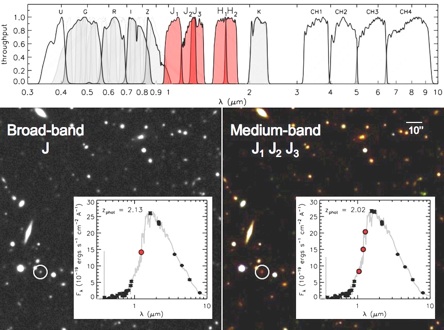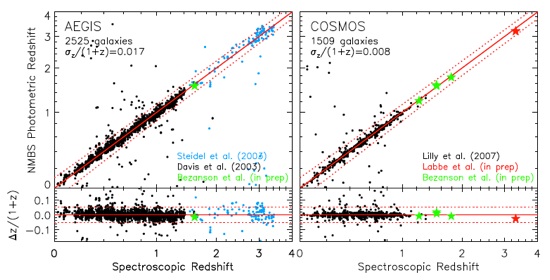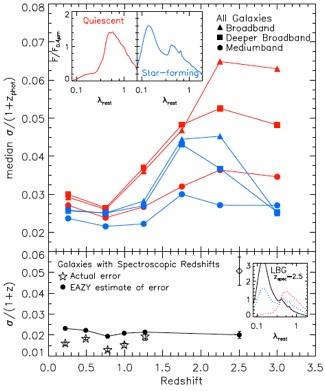The NEWFIRM Medium-Band Survey

The NEWFIRM Medium-Band Survey (NMBS) includes deep near-infrared (NIR) medium-bandwidth photometry over the wavelength range 1–1.8μm in the AEGIS and COSMOS fields (see layout here). The observations were carried out as part of the NEWFIRM Medium-Band Survey (NMBS), an NOAO survey program on the Mayall 4m telescope on Kitt Peak using the NOAO Extremely Wide-Field Infrared Imager (NEWFIRM). We describe the full details of the observations, data reduction and photometry in a forthcoming paper (Whitaker et al. 2011, accepted in ApJ), also presenting a public K-selected photometric catalog along with accurate photometric redshifts and rest-frame colors. The redshifts are computed with 37 (20) filters in the COSMOS (AEGIS) fields, combining the NIR medium-bandwidth data with existing ultraviolet (UV; GALEX), visible (CFHT and Subaru), NIR (CFHT) and mid-IR (Spitzer/IRAC) data (see Figure 1).

Figure 1. A region of the COSMOS field (roughly 2‘ on a side), shown for a broadband J-filter (left) and a three color image from the medium-band J1J2J3 filters (right). The red object in the bottom left of the image highlights the spectral features that we are able to resolve within only 0.2μm in wavelength (see inset SED). The J-filters trace out the Balmer/4000A break with higher resolution than the standard broadband filter, allowing for an accurate photometric redshift of this quiescent galaxy at z=2.02. The normalized transmission curves of the filters in the NMBS catalogs are shown in the top panel; the medium-bandwidth filters are red and the additional COSMOS filters (e.g. the Subaru optical medium-band filters) are shown in grey-scale behind the five CFHT optical filters.
We find excellent agreement with the publicly available spectroscopic redshifts, with σz/(1+z)~1–2% for about 4000 galaxies (see Figure 2). The NMBS catalogs contain >13, 000 galaxies at z>1.5 with accurate photometric redshifts and rest-frame colors.

Figure 2. Comparison between the NMBS photometric redshifts of the deblended catalog and spectroscopic redshifts from the DEEP-2 sample (Davis et al. 2003) and a smaller sample of high redshift LBGs (Steidel et al. 2003) (left panel), and the zCOSMOS survey (Lilly et al. 2007) (right panel). A few preliminary spectroscopic redshifts from Bezanson et al. (in prep) and Labbe et al. (in prep) are included in the COSMOS field. The red dashed lines are for zphot=zspec+/-0.05(1+zspec). The correspondence between the photometric and spectroscopic redshifts is generally very good.
Due to the increased spectral resolution of the five NIR medium-band filters, the average 68% confidence intervals of the photometric redshifts of both quiescent and star-forming galaxies are a factor of two times smaller when comparing medium-band catalogs to broadband catalogs (see Figure 3).
Figure 3. The median 68% confidence interval of the photometric redshifts of quiescent (red) and star-forming (blue) galaxies selected by the UVJ rest-frame color selection technique. The confidence intervals are calculated for both the medium-band and broadband catalogs. The top right inset panels show the difference between the average best-fit EAZY templates of the quiescent (left) and star-forming (right) galaxies, smoothed with a Gaussian to the resolution of the medium-band filters. The bottom panel shows the median confidence interval of only those galaxies with spectroscopic redshifts compared to the actual errors (stars) as determined from the photometric-spectroscopic comparison, with the LBGs indicated separately as a diamond. The best-fit EAZY template for the sample of LBGs at zspec=2.5 is bluer than the average star-forming galaxy, with a weak Balmer/4000 Angstrom break (see bottom right inset panel). The error for both quiescent and star-forming galaxies is up to a factor of two times smaller when using medium-band NIR data as compared to deep broadband data.


Questions? Please email kate.whitaker @ nasa.gov
Last Updated May 24, 2011